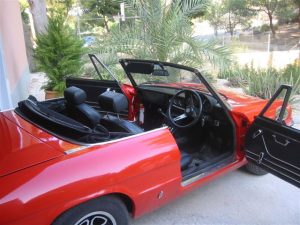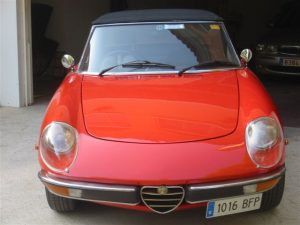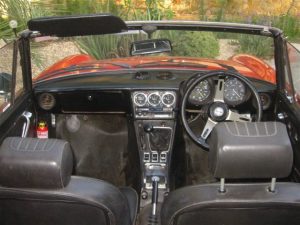 Classic Cars – Why do we love them?
Classic Cars – Why do we love them?
Written by Jeff Sheridan
What is it about old cars that make us want to own one, or indeed for hundreds of thousands of people, to actually go out and buy one? OK they evoke memories of the past, reawakening the daydream we once perhaps had of owning one of the bright, new, shiny packages of chrome and steel that was called an E-Type Jaguar or an Austin Healey 3000.
If the dream stopped here and by that I mean with obviously sought after luxury sports car whether it be a Lotus or a Ferrari it might be understandable. It could be explained as fulfilling that desire to own something that you thought was very special and yet was financially unattainable. However the Classic car movement doesn’t stop with exotic two seaters. It penetrates the length and breadth of the car industry, and in the USA, the UK and parts of Western Europe has become a multi-billion pound industry. Enthusiasts spend thousands of pounds restoring a Ford Cortina, a Leyland 1800 or a Morris Minor. They spend thousands of man hours in cold, often cramped and usually damp garages, risking in the future severe bouts of rheumatism from laying on inadequately cushioned concrete floors – so where is the sense in all this?
The short answer is that it does not make sense but since when did car ownership ever make sense anyway. Such enthusiasts and their projects represent a wonderfully diverse collection of cars from Alfa Romeo’s to Volvos, Citroen 2CV’s to Triumph Stags. Almost nothing is excluded – you only need to look at the 400+ Clubs that exist in the UK alone Perhaps the Classic car movement was born out of a desire to escape from the somewhat bland, sanitised vehicles that the major motor manufacturers insisted was what we wanted. In their drive to sell more and more cars they made them bigger, faster, more comfortable and safer and, almost as a consequence, more boring than ever they imagined. In the frenetic, hideously competitive world of car manufacturing their search to be different from each other made them almost forget about design and resort to an increasing reliance on technology.
Not too long ago the choice of buying a family saloon, from whoever, gave you considerable choice. You had heard about the reputation of manufacturer A against B, or you liked the better guarantee of B against C and so on. You knew the gearbox of D was excellent whilst that of E seemed prone to problems. The cars also looked different and drove differently. It was very much a decision of personal preference. Now there is very little to choose between models and between manufacturers. They all provide very comfortable, fairly spacious interiors, with reliable engines and transmissions, extensive guarantees against defects and so on. You may still have a choice of model or make but the end product is, in many ways, almost identical in how it handles, in it’s economy and performance except that now each manufacturer also tries to be as Green as they can so low CO2 emissions have now replaced the old 0-62 and 0 – 100 speed times. A Volvo S40 1.6 petrol performs in much the same way as the equivalent engined Toyota Corolla Saloon or a Ford Focus.
Witness the remarkable growth in 4×4 vehicles. Originally a market segment aimed at the Country Set it was not long before manufacturers realised that these large vehicles were an excellent means of conveying to others that they had arrived at a certain social level. They didn’t need the vehicle but they did need it’s presence. Now, instead of one or two manufacturers dominating the field almost every car maker proudly boasts of such a beast in their range. Yet it seems to me that they are in many ways amongst the most impracticable vehicle ever made unless you happen to live in the Sahara Desert or on the top of a mountain range. Sure you get a great drivers view but that is not what it is all about. The image is the thing – the my one is bigger and better than yours syndrome. Every one of these battle tanks as someone once called them are big, very thirsty, even with their diesel engines, and the devil’s own job to park. Not because they are heavy or cumbersome – oh no a small child can turn the wheel such is the power assistance given. Rather the difficulty is due to size and this is especially so in many parts of Spain where it is my firm belief that car park builders used the Seat 600 as their role model. But hey – if people want to buy such a machine that is up to them. Freedom of choice is the thing. These modern chunks of metal have become status symbols to our increasing prosperity and disposable wealth.
OK I realise that I am talking in generalities and that there are exceptions and I am also not suggesting that you can turn your back on progress. It has been inevitable that as cars developed so did their operating systems. Steering wheel systems became powered and then speed sensitive, brakes changed from drums to discs and then you added ABS. Engine ignition was improved with fuel injection systems, dynamos became alternators, suspension systems changed from leaf springs and live rear axles to independent all round and so on ad infinitum. In fact you have eventually ended up in this early part of the 21st Century with cars which feature so many safety and technological wonders you begin to question the role of the driver. Actually move your hand to start the wipers – no, we now have rain sensitive windscreens: switch on your headlamps as it gets dark – no we have light sensitive headlamps: move your seat for adjustment, well yes you move your hand but only to make contact with an electric switch: dip your rear view mirror for headlamp glare – well no it adjusts automatically etc.; the list is ever growing. Old fashioned heaters are now multi-tasking air/climate control systems, some sophisticated enough to provide optional levels of comfort between front and rear and some even between left and right. More and more the passengers in a car are isolated from the external environment and whilst this might be a good thing the lack of feeling a modern car exhibits is to many people now almost counter productive. Indeed I would argue that despite cramming every possible safety device developed by man’s ingenuity into every modern car they are in danger of actually becoming more dangerous to drive.
Cushioned from almost every bump and irregularity on the road, told how smooth and swift and (safe) your car is, how it can accelerate you out of trouble etc, informed that automatically the vehicle will compensate if you enter a bend too quickly and the days of a complete automated machine cannot be far off. But it also temps the driver, especially an inexperienced one, to drive too quickly, trusting in the car to save them from any mistakes that surely will be made. We all know that enthusiastic marketing does not always live up to it’s exagerated promises.
In those simpler days of the sixties and seventies cars tended to slot into their place. If you saw a TR3 or XJ Jaguar in your rear view mirror you usually expected that this car would eventually overtake you in your family saloon. Not today however; even your everyday family saloon, and especially some of the enhanced performance hatchbacks with their refined engine installations, can almost out perform any sports car from the recent past. Today the engine size, if labelled, is one of the few markers that warn you about a cars performance and in some manufacturers even this is now an optional delete. Therefore many cars go round as wolves in sheep’s clothing and a few as sheep in wolve’s clothing.
But car ownership did not use to be just a matter of driving. As your vehicle got older and if you were happy with your choice you were often tempted to do some DIY to keep the always escalating service costs down.
Unfortunately it is no longer an easy matter for the car owner to service his or her own vehicle. With the advent of electronic engine management systems, extremely sophisticated suspension systems, dynamic stability control systems etc. it is almost impossible for the DIY person to fiddle with the car unless there is access to diagnostic equipment costing many thousands of pounds. The days of having a good set of spanners and general tools with which you could tackle most jobs are long gone. In any case the days of repairing anything mechanical seem to have flown away in the face of increasing cost competitiveness and the need to reduce labour costs. So today the part is replaced even if the actual repair might have been relatively cheap compared to the cost of replacement.
So why is it that we want to hold onto cars from yesteryear? Maybe part of the answer is now beginning to emerge. A major aspect of this need / interest is nostalgia. Even the manufacturers have recognised this factor in the growth of interest in classic cars. Witness the growth of companies who produce replica cars, or those who customise cars with every modern device but leave the body as original. Look at the retro looks of cars like the S Type Jaguar ( with design echoes reminiscent of the old Mark 11 and original S Type cars), the Mazda MX-5 ( a copy of the original Lotus Elan ? ) and Z Model sports car from BMW. There are many others around too numerous to mention. They are all trading on our love for retro-styling. And then there are the Classic Car Dealers. One step above the Second -hand car dealer or are they? If I had a pound for the statement probably the best example in existence or an under valued car at present or will soon be an appreciating asset I would be driving a Ferrari F40.
Classic car owners also contribute to expanding the Classic car phenomenon. Their hyperbole can reach great hights from the reasonable It’s obtainable, affordable, practical and forever cool about a Ford Capri Mk 1. to the patently absurd …the driving experience is closer to piloting a spaceship about a Citroen DS.
We remember the cars our fathers and mothers drove, indeed we were ferried around in them for many years. We saw or remembered some of the new models being unveiled and delighted in their differences. The XK 120 Jaguar was like nothing anyone had seen before and Jaguar kept us on are toes with later models like the E-Type and the XJ Saloons, the latter being decades ahead of their rivals. But it wasn’t only the more upmarket cars that were different. Think of the range of cars brought out by Ford – from Escort to Granada, or Rover with the famous Aunty Rovers, the P3 60,75, 90, 105 to the P5 Coupes and saloons etc. The swinging sixties also saw a complimentary growth in Sports cars but all so very different from each other. The almost eternal Moggie, the extremely successful TR range from Triumph, the MGA, MGA Twin Cam to the iconic MGB, even the Daimler Dart and the growth of the mini sports car such as the Frogeyed Sprite, Triumph Spitfire and MG Midget all added character to the car scene of the sixties and seventies.
Quentin Wilson ( of BBC Top Gear fame ) said in the introduction to his book The Ultimate Classic Car Book ….Our affair with old cars is purely emotional, fiercely partisan, terminally subjective and completely without logic or order. I suggest that this statement probably neatly encapsulates the feelings of most of us who are involved in one way or another with the Classic car movement. We actually enjoy getting our hands dirty from time to time. The British especially would be lost if they couldn’t have a moan about their car when it goes wrong whilst, perversely, extolling it’s virtues to anyone who will listen on every occasion that it runs without a problem. Note the reaction of the Spanish public when we take our cars out in convoy and park up in a town centre. They clap and wave as we drive past ( no doubt our passing convoy reinforcing their stereotype image of the eccentric British ) but they also crowd round the vehicles when parked and look with genuine interest and affection at vehicles from an age gone by. Maybe that is why we join a Club to share our pleasure with others of a similar persuasion. Perhaps we love these cars because they bring a smile to our face as we meander through the Spanish countryside, or because they generate a little warm feeling within our souls. But perhaps most of all because they are just good old fashioned fun to drive.
Maybe you have a different reason for owning a Classic or maybe you think that the above is just a lot of hot air. Why not share your views on our Website – after all exchanging opinions about our Classics is supposed to be part of the fun of joining the Club.
NOTE: The Club is reliant upon the information/photographs supplied by members and, although every care goes into the management of the web site, the information is supplied by third parties. Therefore, the Club can accept no legal liability for any omissions, misunderstandings, errors, infringement of copyright laws or claims made by a user of any of these articles.


